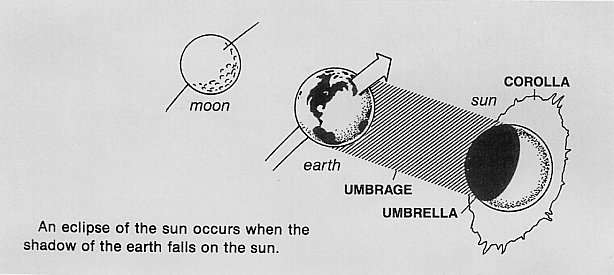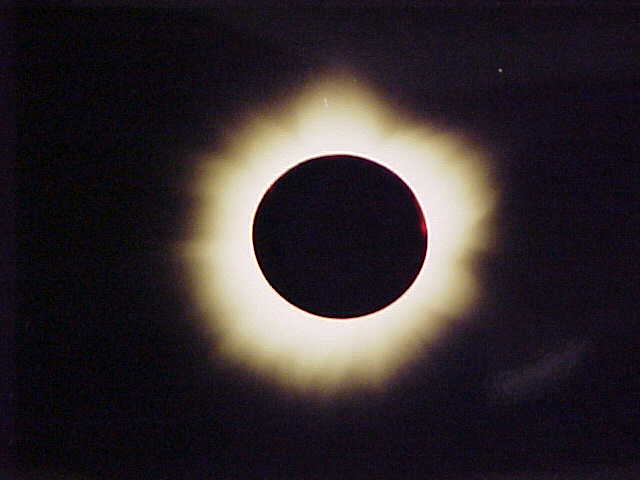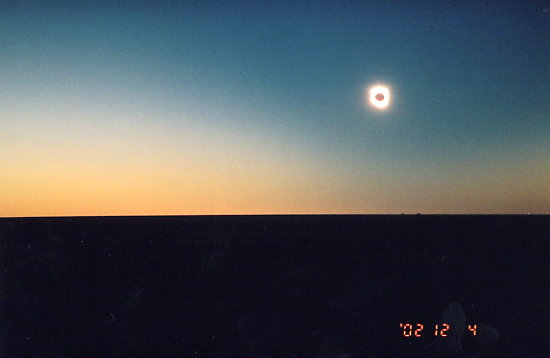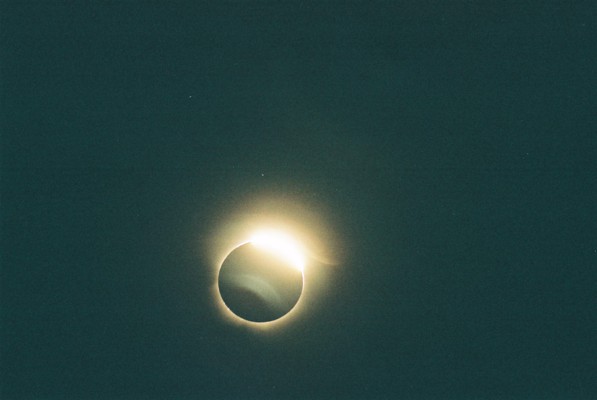

A total solar eclipse is a wonder of the astronomical world. We have the seven wonders of the natural world, the seven wonders of the ancient world, and the seven man-made wonders of the world. There are three View-Master reels, twenty-one wonders of the world to be seen in their three-dimensional glory. Maybe the astronomers should catalogue seven wonders of the celestial world. I suspect astronomers would pick more subtle phenomena than I would, but the most dramatic heavenly events are eclipses, where the sun or the moon goes away in the sky.
There are many wonderful eclipse web sites.
I rely on
Fred Espenak's
supported by NASA.
You can always use
Google
to search for the string
total solar eclipse.
There are some nice web sites out there,
well worth looking at.

The astronomy
behind eclipses is simple enough.
The earth and moon orbit each other and,
every once in a while,
the earth, moon, and sun line up in a nearly-perfect row.
In the science-textbook picture of the sun, earth, and moon orbits,
it looks like this should happen twice each month,
but the real orbits of sun, earth, and moon are at an angle
so the three bodies only line up a few times each year.
When the earth comes directly between the sun and moon,
the entire moon is plunged into darkness for about an hour.
Seen from the earth (where most of us live),
a curved shadow moves across the face of the full moon
which retains a ghostly red glow until the bright moon
reappears on the other side.
Anybody on earth who can see the moon will see this eclipse
because the darkness is actually on the surface of the moon.
The challenge in seeing a lunar eclipse
is staying up late enough, remembering to go outside,
and waiting for it to happen.
If you miss one because it happens during the day,
then you can hang on and wait until the next one.
Lunar eclipses are frequent enough
that they're seldom worth traveling for.

When the moon comes
between the earth and the sun,
the greater spectacle of
a total solar eclipse can happen.
Seen from the earth,
the sun and moon are almost exactly the same size,
half a degree of arc,
so the moon almost exactly covers the disk of the sun.
That almost-exact size match is both the rub and the glory.
It is the rub
because the eclipse is only total on a tiny area of the earth,
the part in the darkest part of the moon's shadow,
called the umbra.
An area about twice the size of the entire moon,
the penumbra,
can see a partial eclipse.
Sometimes the moon's orbital path is far enough away from the earth
that the umbra does not reach the earth's surface at all.
Instead there is a zone where earth viewers
see a ring of sun around a dark shadow of moon,
an annular eclipse.
(The word "annulus" is Latin for "ring.")
It is the glory
because the near match in size
means the moon covers the disk of the sun
almost perfectly.
That would not be terribly spectacular
except that the sun's terribly bright photosphere
is surrounded by the corona,
a beautiful part of the sun normally overwhelmed
by the blue sky,
photosphere light scattered by earth's atmosphere.
(I presume that, out in space,
one can view the sun's corona by holding a small object,
perhaps a thumb, over the disk of the photosphere.)
The moon-sun size-match is so close that solar flares,
called prominences,
are often visible on the surface of the sun.
This is our chance, as ground-bound earthlings,
to see parts of our own sun that are otherwise obscured
by the brilliance of the photosphere.
And, as luck would have it,
this event is only visible from a small part of the earth.
The stages of an eclipse:
First,
some smart people with some computational savvy
figure out the motions of the sun, earth, and moon
to calculate the exact time and location of an eclipse.
Digital computers help the process,
but astronomers knew eclipse schedules centuries ago
when they had nothing but pen, paper, and their wits.
A bunch of entrepeneurs plan out long, expensive trips
and a bunch of enthusiasts sign up for these trips.
(As a non-eclipse-fan might see it,
a bunch of idiots pay a lot of good money
to travel to places that nobody would ever want to go
just to experience a couple minutes of darkness.)
The planning process is made more involved
by long-term weather forecasts.
For example, on 2002 December 4,
the eclipse path cut through Africa in the morning
and South Australia in the evening.
The African eclipse path promised about a minute and a half
of totality but had a 70 percent chance of cloud obscuration
as December starts the rainy season
(and the malaria season) in southern Africa.
The Australian path had only a 30 percent chance of clouds
but the total eclipse time would be less than half a minute.
Further inland in Australia promised better weather probabilities
and shorter total eclipse times closer to sunset.
Second,
the eclipse enthusiasts
gather at their appointed place
waiting for the Big Event.
They are often armed with binoculars, telescopes,
and all kinds of fancy cameras.
The people who wander all over the globe to see eclipses
tend to be astronomy buffs,
so there is often a "star party"
where a bunch of folks stay up late
and together view objects in the heavens.
Eclipses in the Southern Hemisphere
elicit more of this kind of attention
as most eclipse viewers are Northern Hemisphere residents
who seldom get to see the southern sky.
The Southern Cross dominates the June winter sky
and the December summer sky has Orion's sword
pointing up instead of down.
Third,
the eclipse enthusiasts
are all lined up with their gadgets on a sunny day
waiting for the Big Event.
At least we hope it's a sunny day.
We have some equipment for viewing the sun
because the photosphere disk itself is very bright.
Dark eclipse glasses are popular
and some are officially sanctioned
by people who know what they're talking about.
Another approach is to use a pinhole and a viewing screen,
usually a piece of paper, a meter or two away.
The sun's disk is half a degree of arc,
about one centimeter for each meter of distance.
Another approach is to use a pair of binoculars
as a projector to get a larger image of the sun's disk.
Fourth,
a chip appears in the side of the sun,
easily visible to the unaided eye through eclipse glasses.
(I say "unaided" rather than "naked"
because of the eclipse glasses.)
That chip gets bigger and bigger until the sun forms
an obviously shrinking crescent in the sky.
For the first fifty minutes or so,
the sun's area is shrinking and
people are getting more excited,
but nothing else is happening.
As children, we have all been told
not to look directly at the sun because it is too bright.
This danger is greater at a solar eclipse
for two reasons.
Before local eclipses,
both the English and Australian governments
have warned people not to look directly at the eclipse at all
to prevent eye damage,
and, instead, to watch it on television.
I would caution people to avoid watching television
to avoid brain damage.
I know I did not travel thousands of miles
to watch an eclipse on TV or on a web page.
The first reason an eclipse is dangerous
is the plain and simple reason that it is tempting to watch it.
Normally, I have no reason to gawk at the sun in the sky.
I might glance that way for a second or two
and find myself seeing a green-blob after-image
for a few minutes.
That's about as harmful as the sun gets in everyday life.
But a partial eclipse is something to look at,
something interesting,
and people are tempted to stare at it.
Solar brightness is unlikely to damage a human eye in a few seconds
but minutes of continuous viewing can do serious eye damage.
The second reason an eclipse is dangerous
is that the overall ambient light level is dwindling
but the remaining sun in the sky
is just as bright as the full daylight sun.
So your eyes are adapting to twilight darkness
while the sun that you're just dying to stare at
is at its full brightness.
While eye experts will tell me my actual numbers are full of shit
(and they're right),
the reasoning is sound, so bear with me.
Consider the time when the sun is ninety-percent covered by the moon.
The ambient light level is one-tenth of normal daytime
and the eye has adapted by becoming ten times as sensitive to light.
(In fact, the actual change in pupil size is less than ten-to-one,
but bear with me.)
When you look at the solar crescent with your dark-adapted eye,
ten times as much daylight is reaching your retina
as it would during a normal sunny day.
Another way to look at it is that the total daylight is concentrated
into one-tenth as much sky.
Whichever way you look at it,
as the sun's area shrinks in the sky,
our dark-adapted eyes are in increasing danger
of damage from direct solar viewing.
So be careful!
Fifth, after almost an hour of sitting around
peeking at the shrinking sun through eclipse glasses
and gawking at crescent shaped sparkles amid shadows,
the excitement begins a few minutes before totality
and things start happening fast.
It is now getting noticeably darker and colder.
Any animals in the area are getting quiet
as if it were twilight,
so there is a hush of anticipation in the air.
The sun is now a tiny curved slit in the sky.
The ground may have lighter and darker patches
moving like the pattern on the bottom of a swimming pool.
These shadow bands
are caused by the same atmospheric variations
that make stars twinkle.
The sun's presence in the sky is small enough to "twinkle,"
but it is so bright that its twinkling manifests itself
in these shadow bands.
I have only seen shadow bands in one of my four total eclipses.
Sixth, as the sun is winking out,
it is reduced to a tiny area
of disconnected sun-bright points in the sky
called Baily's beads.
The gaps are mountains on the moon's surface
and the total eclipse is just a few seconds away
as these beads disappear.
Seventh, it is dark,
there is a black hole in the sky where the sun used to be,
and the corona is
visible in all its glory.
Each time the corona is different,
blown into changing shapes by various solar winds
of one sort or another.
We use exponential units to define ratios of brightness,
and there are several different choices of measurement.
A decibel (dB) is a ratio of about 1.26 so
10 dB is a factor of ten.
We use decibels in audio and radio.
Astronomers use magnitudes
and each magnitude is 4 dB so
five magnitudes is a factor of one hundred.
Photographers use f-stops
where each f-stop is 3 dB, a factor of two.
So a factor of one thousand is
30 dB, 7.5 magnitudes, or ten f-stops.
The best analogue films can render a range of
about seven f-stops
(20 dB, 5 magnitudes, a factor of one hundred)
and no photographic reproducing medium comes close
to that kind of range.
Typical "high-resolution" digital displays
have a theoretical maximum range of 255-to-1, 24 dB,
but I don't think any monitor or paper
realistically reproduces that kind of contrast
in illumination or albedo.
We have the same issue in audio reproduction
where a musical event has interesting stuff happening
over a 60 dB range and even the best hifi equipment
cannot resolve detail over that kind of range.
The usual photographic tactic for total solar eclipses
is to concentrate on just one part of the picture,
a short exposure for the inner corona only
and a longer exposure for the outer corona
with the inner corona overexposed.
An even shorter exposure renders the solar flare activity.
Some digital photographers take a bunch of pictures
and mix them into a single image that shows some detail
for every part of the picture,
a high-tech version of the after-eclipse sketch.
My own strategy is to point my automatic Olympus camera
on a tripod in the direction of the sun
and to press the shutter button a few times during the eclipse.
The results
are sometimes pretty good.
The black hole of the moon isn't competely dark, either.
After all, the moon is seeing a full earth
(with a small, dark dimple where the moon casts its shadow)
and
lunar features
can be seen in an appropriately overexposed eclipse photograph.
As bright as the
dark side of the moon may be,
it is overwhelmed by the inner corona.
A total solar eclipse has an astounding range of brightness.
The inner corona is about 30 dB brighter
than the outer corona.
The darkness surrounding the eclipse is not quite night,
dark enough to see planets
but not always dark enough to see stars.
The horizon is not dark because it is still sunlit.
There is a penumbral glow
from the edge of the umbra of the moon's shadow.
A viewer with a pair of decent binoculars can see red flares,
enormous storms on the surface of the sun.
These prominences are the side-view of sunspots,
to put it loosely.
A three-minute eclipse is a busy time
to gaze at the corona,
to use binoculars to look for solar flares,
and to take pictures.
Every total eclipse has some kind of diamond ring effect at the end,
but sometimes the moon is positioned so there is a large canyon
at the edge,
so the diamond ring is especially beautiful.
Photographs and images of the diamond ring
cannot hope to render the single point of brightness
that makes the ring so magnificant,
so they create some pattern of light,
a blob or some rays
at maximum saturation,
to use quantity where intensity is not available in the medium.
I liken the entire eclipse photographic process
(or Handel's "Messiah" on a hifi)
to taking pictures of the Grand Canyon.
If you have seen the real thing,
then you don't need the pictures.
If you have not seen the real thing,
then the pictures will not begin to communicate
why somebody else went to all the trouble to experience it.
I still went through a bunch of rolls of film
in my two Grand Canyon visits
(driving a car and flying a light airplane)
because the pictures remind me of what I saw.
That is why I'm always so anxious to get pictures
of each eclipse.
But showing pictures will not convince the unconverted
to become eclipse chasers like us.
Now we're back to eclipse glasses and pinhole projections
as the photosphere is back in the sky,
a very thin crescent that grows back into the full disk
over an hour.
Then the eclipse is over.
Why do eclipses vary so much?
The moon and sun vary in size in the sky,
so the amount of time can be a few seconds
or nearly seven minutes.
The moon moves about 3500 Km/hour in its orbit
and the rotating earth is moving
the same direction
almost half that fast at the equator,
so eclipses at the equator have the double advantage
of being 7000 Km closer
and having a slower relative motion of moon and viewer.
The sun is farthest from the earth in June
and closest in December.
June eclipses can be longer,
especially if the moon is obliging enough
to be at a near point on its own orbit,
for a smaller sun and larger moon allow a longer blackout period.
Shorter eclipses allow more features
near the surface to be seen,
so they have their advantages.
People always seem to see a lot during eclipses.
In Woomera, South Australia, on 2002 December 4,
I enjoyed the corona and saw no prominences with my naked eyes.
Since the total eclipse was only twenty-six seconds,
I decided not to try to use my binoculars.
I took a quick look to notice the sky was brighter
north and south than it was east and west
because the eclipse was near sunset
and the moon's umbral shadow was oblong as a result.
I saw the most beautiful diamond ring I have ever seen.
When the partial sun was setting
I saw no
green flash
from either horn of the crescent.
However, I did see
the Loch Ness monster
the next day from the bus.
Why do eclipses seem to happen in remote places?
It isn't
Ripley's Believe It or Not
where amazing thing always seem to happen
someplace amazingly far away.
The fact is that a 50 Km-wide line drawn across
the earth's surface at some arbitrary place
is not always going to reach places where
a lot of people live.
Sometimes there is a populated path
like the 1999 August 11 eclipse
that ran through the heart of Europe.
And sometimes there is an unpopulated path
like the 2002 December 4 eclipse
that ran through sparse areas of Africa and Australia
with most of its path in the Indian Ocean.
The 2003 November 23 eclipse in Antarctica
is even more remote with Mirnyy (the Russian base)
being the closest thing to a population center on its path.


